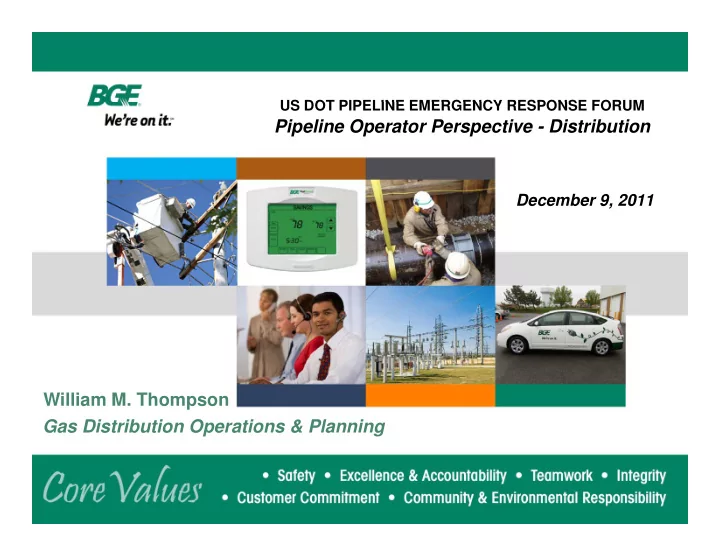

US DOT PIPELINE EMERGENCY RESPONSE FORUM US DOT PIPELINE EMERGENCY RESPONSE FORUM Pipeline Operator Perspective - Distribution December 9, 2011 William M. Thompson Gas Distribution Operations & Planning
Introduction Who We Are Emergency Management Drivers Emergency Management Strategy T Types of Events f E t Internal & External Challenges What BGE is Doing What BGE is Doing Industry Recommendations Summary Pipeline Emergency Response Forum 2
Who We Are BGE serves more than 650 000 residential and business gas customers BGE serves more than 650,000 residential and business gas customers Miles of Distribution Main: 6,905 miles Miles of Transmission Main: 165 miles 3,000 square-mile area encompassing Baltimore City encompassing Baltimore City and all or part of 10 Central Maryland counties. Pipeline Emergency Response Forum 3
Emergency Management Drivers Corporate Vision & Mission − Core Values Core Values Regulatory Compliance − CFR 49 192.615 & 192.616 − API 1162 API 1162 − COMAR (Code of MD) − OSHA 1910.120 − NFPA 471 & 472 Good Business Practice − Economics Pipeline Emergency Response Forum 4
Emergency Management Strategy Mitigation & Prevention Reduce Risk Preparedness Operational Readiness Coordinated Approach Coordinated Approach Response Integrated Response with Strategic Priorities Recovery Restoration and Continuity Restoration and Continuity of Operations Emergency Management Continuum Pipeline Emergency Response Forum 5
Emergency Management Strategy Environmental Awareness Leadership Engagement p g g Training Exercise Performance Assessment Continuous Improvement Continuous Improvement Pipeline Emergency Response Forum 6
7 Emergency Management Strategy Pipeline Emergency Response Forum
Types of Events I HIGH POTENTIAL LOW IMPACT EVENTS HIGH POTENTIAL, LOW IMPACT EVENTS Small leaks on the gas system Gas odor calls Gas odor calls Third party damages Small fires Pipeline Emergency Response Forum 8
Types of Events II LOW PROBABILITY HIGH IMPACT EVENTS LOW PROBABILITY, HIGH IMPACT EVENTS Transmission pipeline rupture or strikes Large scale gas system outages Large scale gas system outages Fires or explosions involving gate stations Natural Disasters Pipeline Emergency Response Forum 9
Internal & External Challenges Establishing and maintaining Establishing and maintaining organizational focus & engagement Engaging the various police departments in training and awareness programs Determining how to most effectively share detailed effectively share detailed emergency response plan and infrastructure information with response officials p Pipeline Emergency Response Forum 10
What Is BGE Doing Actively engaging emergency response officials by hosting annual Emergency Management Agency organization and LEPC meetings Providing on site training to local emergency responders and 911 Call Centers Facility tours and joint drills with emergency responders Continuously assessing and improving our Public Awareness Program’s effectiveness Utilizing industry expertise (consultants) to assist BGE in developing plans and performing internal assessments Partnering with our pipeline suppliers to conduct combined drills and perform basic emergency operations on each other’s system valves. Sharing our processes with other pipeline operators Participating in industry associations, workshops and conferences Pipeline Emergency Response Forum 11
Industry Recommendations Responders are increasingly short of time for training and preparedness; need ease and simplicity in training. p y g Develop relationships before they are needed - There was a very strong emphasis on the need for face to face communications just to establish a relationship so that if an event occurs, people know each other. Share information on high risk sites - More advanced planning should include identifying locations with other infrastructure, like railroad cross-over(s), co- location of water infrastructure, and other high consequence factors. Emergency Responders are the incident commanders and responsible for all E R d h i id d d ibl f ll emergencies - Operators join the Unified Command and share in the decision making based on providing specific product and packaging expertise. expertise. Pipeline Emergency Response Forum 12
13 Pipeline Emergency Response Forum Thank You Thank You Pipeline Emergency Response Forum
Recommend
More recommend